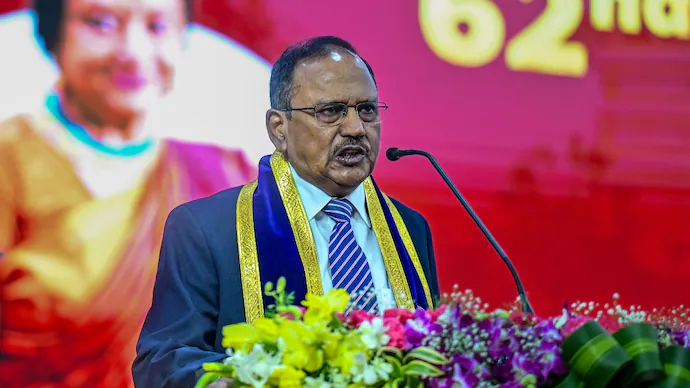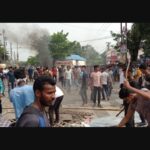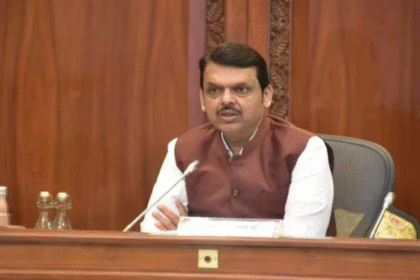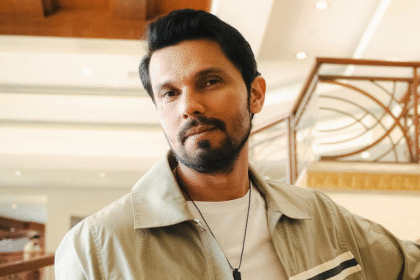Operation Sindoor — Inside Ajit Doval’s Defiant Response to India’s National Security Critics
As regional tensions flared across the Middle East following the Israel-Iran missile exchanges, India’s response was both swift and deeply calculated. At the heart of that strategy stood Operation Sindoor—a multi-layered security and evacuation mission quietly deployed across borders. Far from being a single-move response, Operation Sindoor was India’s attempt to simultaneously secure its diaspora, fortify its critical infrastructure, and project geopolitical steadiness amid a theatre of instability. While the operation remained classified in many respects, the presence of visible patterns in India’s diplomatic and military positioning revealed a playbook carefully crafted under the supervision of National Security Advisor Ajit Doval.
What distinguished this operation was its composite nature. Unlike kinetic actions seen in past border tensions or surgical strikes, this was a hybrid response—merging cyber preparedness, civilian protection, diplomatic agility, and psychological warfare. When Doval publicly dared critics to produce even one photo of infrastructural damage within Indian borders, it was not just a rhetorical device. It was a calculated declaration of success: no strikes on Indian soil, no confirmed cyber breaches, no internal destabilization, and, most importantly, no casualties within India. In an era where information warfare and misinformation campaigns often define public perception more than battlefield outcomes, Doval’s confidence was as much about narrative control as it was about operational outcomes.
Behind the scenes, India activated a wide range of assets. High-alert protocols were placed on key military establishments, including naval zones along the western seaboard, airbases in Rajasthan, and forward surveillance units monitoring both Pakistan and Iranian-linked activity. But perhaps more crucially, Indian embassies across Gulf countries worked around the clock to map out and execute evacuation plans for vulnerable citizens. The coordination between the Ministry of External Affairs (MEA), the Indian Air Force, and local intelligence cells resulted in the safe repatriation of over a thousand Indians, with no recorded incidents or logistical failures. Flights were rerouted, diplomatic corridors were opened through allies like Oman and the UAE, and local Indian community networks were activated to serve as interim shelters.
Equally significant was India’s cyber posture during this period. Intelligence insiders, while refusing to go on record, acknowledged that the National Critical Information Infrastructure Protection Centre (NCIIPC) issued red alerts to data hubs handling defense, space research, energy grids, and financial infrastructure. There were reports of attempted intrusions—possibly originating from state-sponsored groups based in hostile regions—but these were apparently neutralized before they could reach critical thresholds. The successful shielding of India’s cyberspace during such a tense global moment underscores the evolution of India’s digital preparedness—a space Doval has long prioritized, often arguing that future wars would be fought in the shadows of servers, not just on ground.
Doval’s statement—”Show me one photo of any damage in India”—must also be read as a repudiation of disinformation tactics that sought to exploit fear. In the days preceding his address, social media had erupted with viral images of explosions falsely labeled as Indian naval base attacks, grainy satellite visuals claimed to show damage near Gujarat’s ports, and WhatsApp forwards alleging Indian missile deployment. None of these held up under verification. In that environment of digital confusion, Doval’s challenge was less a boast and more a reaffirmation of credibility: if you are going to question the nation’s security apparatus, you must present truth, not Twitter hysteria.
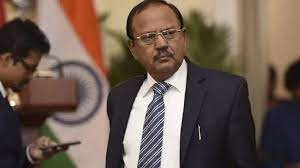
International response to India’s restraint was telling. While the United States and Israel continued their high-alert coordination, both publicly acknowledged India’s composed and independent role during the crisis. The U.S. State Department referred to India’s diplomacy as “stable and responsible,” while strategic analysts in Israel noted India’s importance as a silent ally in maintaining regional equilibrium. This is where India’s post-2020 geopolitical strategy becomes clearer—one that balances assertiveness with mature restraint, always ready to act but rarely loud about it. Operation Sindoor didn’t need a global press briefing; it needed precision, results, and domestic calm—and that’s what it delivered.
Yet, it would be incomplete to view this phase purely through a strategic lens. The operation also served as a test of India’s internal civil-military synergy. State governments were brought into the fold discreetly; hospitals in Gujarat and Maharashtra were issued silent emergency advisories; and information flowing from the National Security Council Secretariat (NSCS) to home ministry offices ensured that if escalation occurred, India’s first responders would be prepared. In the end, those worst-case scenarios never materialized. But the infrastructure to manage them was visibly in place.
Part 2 of this account demonstrates how India, under Doval’s watch, executed a silent masterclass in modern national security—multi-agency collaboration, non-escalatory posture, rapid logistics, and above all, confidence without spectacle. What makes the episode historic is not only the absence of damage but the presence of layered control behind the scenes.
In the days following Ajit Doval’s emphatic challenge—“Show me one photo of any damage in India”—the political and media landscape in India reacted in predictable, yet revealing ways. For a country that exists within the bounds of a noisy democracy and a volatile geopolitical neighborhood, moments like these often transcend the immediate security context. They become lenses through which larger questions are examined: Who owns national security? How transparent should strategic affairs be? And who has the authority to declare victory?
The first wave of response came from opposition benches. Leaders from Congress, AAP, TMC, and smaller regional outfits cautiously acknowledged the lack of material damage on Indian soil but did not waste time pointing to what they called a “lack of clarity” around the full scale of Operation Sindoor. Some demanded a special briefing in Parliament. Others framed Doval’s remark as dismissive toward the growing concern among citizens about escalating regional conflict. Rahul Gandhi, in a press interaction, stated that “national security is not just about damage control but about open accountability.” While these statements made headlines, they largely failed to dent the broader public perception that India had, at the very least, handled the situation with efficiency and restraint.
The media coverage was a mirror of the national mood—divided along ideological and editorial lines. Television debates across mainstream English and Hindi news channels swung between lauding the government’s invisible shield and demanding greater transparency about what exactly Operation Sindoor entailed. Some anchors celebrated Doval’s statement as a confident assertion of sovereignty and tactical superiority. Others pressed for details: What intelligence inputs had been used? Were any targets neutralized preemptively? Why had the Prime Minister remained silent during the peak of public anxiety? In short, the coverage didn’t challenge the outcome—it challenged the opacity.
Social media, often a litmus test for real-time public sentiment, appeared to side with the state. Hashtags like #DovalDoctrine, #NoDamageIndia, and #SindoorShield trended for over 48 hours. Influencers and commentators—cutting across ideological lines—largely echoed the sentiment that India had weathered a potential crisis with maturity. Still, voices critical of the central government highlighted the dangers of centralizing security decision-making within an unelected, largely unaccountable apparatus, as represented by the National Security Advisor’s office. Doval, while a civilian, has long held the influence and operational control that rivals or even exceeds that of India’s service chiefs—a reality that continues to spark debates on democratic checks and balances.
To understand Doval’s positioning in this saga, one must revisit his broader strategic philosophy. Since his appointment as NSA in 2014, Ajit Doval has reshaped the very grammar of Indian national security. Gone are the reactive, often bureaucratic impulses that governed India’s posture in earlier decades. In their place is a hybrid model of response: swift, agile, often covert, and deeply media-conscious. The Doval doctrine—if one can call it that—rests on three pillars: preemptive intelligence-based action, strategic ambiguity in public messaging, and visible deterrence without prolonged deployment. Operation Sindoor fits perfectly into this framework. It was not a war. It wasn’t even an official “operation” in conventional military terms. It was a comprehensive posture event—a show of readiness without provocation, a shield that didn’t need to swing.
Yet, Doval’s remark was not simply operational. It was political. By asserting that not a single photograph could prove Indian vulnerability, he was effectively pushing back against a growing trend of ‘crisis exaggeration’—a trend in which every cyber rumor, every intercepted satellite image, and every obscure social media claim is amplified into strategic concern. Doval’s stance placed the burden of proof on the accuser. In doing so, he positioned the Indian state as competent and composed, refusing to be baited by either foreign propaganda or domestic skepticism.
This tactic also served another subtle but important purpose: it shielded the armed forces and intelligence agencies from the spotlight. In a crisis where operations must remain classified, Doval absorbed the public scrutiny onto himself. Whether one agrees with his tone or not, the method is textbook: maintain operational security, deflect pressure, and control the narrative arc until de-escalation is secure. In that regard, Doval’s public-facing role is not simply administrative—it is narrative warfare by another name.
Critically, the government’s silence in the days that followed reinforced Doval’s finality. There were no follow-up statements from the Prime Minister’s Office, the Defence Ministry, or the MEA. It was as if the state had spoken once and would not speak again. In a media ecosystem addicted to constant feeds, this decision came across as deliberate—and, in some quarters, unnerving. But it achieved what it set out to do: it ended speculation. In a crisis environment, silence backed by calm often carries more authority than noise backed by uncertainty.
Part 3 reveals that Ajit Doval’s statement was far more than a press soundbite. It was a pressure valve, a strategic endnote to a tense fortnight in India’s foreign and domestic affairs. More importantly, it was a declaration of confidence—not just in India’s capabilities but in its ability to resist panic. While critics may continue to ask questions, the public consensus remains that Operation Sindoor was executed not just in physical terms but in psychological ones as well.
While Operation Sindoor unfolded behind a veil of operational discretion, its most visible arm was humanitarian: the safe extraction of over 1,000 Indian citizens from conflict-impacted regions in West Asia. This was not the first time India had conducted large-scale evacuations—previous missions during the Yemen conflict in 2015 and the Russia-Ukraine war in 2022 had demonstrated logistical resolve—but this instance carried a distinctly sharper edge. The volatility in the region was more sudden, the threat to Indian lives more ambiguous, and the surrounding global narrative more politically charged. In that environment, India had to act swiftly, precisely, and without inviting unnecessary diplomatic friction.
At the heart of the evacuation effort was coordination, not improvisation. Multiple Indian embassies in countries including Iran, Israel, Lebanon, and the United Arab Emirates operated as real-time command centers. Indian nationals, many of them students, technicians, and construction workers, were instructed to register their coordinates, upload identity proofs, and await guidance. These efforts were powered by the Ministry of External Affairs in Delhi, working in tandem with Air India, the Indian Air Force, and local consular staff who often operated in areas where missiles were falling within a few hundred miles. Not a single Indian casualty was reported—a logistical achievement underscoring India’s growing maturity in crisis diplomacy.
The geopolitical choreography of these evacuations cannot be overstated. India, while maintaining diplomatic neutrality in the Israel-Iran confrontation, had to secure safe passage from both sides. It was a test of New Delhi’s balancing act: the ability to maintain warm relations with Tel Aviv while preserving strategic autonomy with Tehran. Behind closed doors, messages were exchanged, clearances sought, and informal guarantees negotiated. According to senior sources in the South Block, Ajit Doval himself maintained secure channels with interlocutors in both capitals, leveraging long-standing relationships and mutual respect. The fact that neither Iran nor Israel obstructed or politicized the evacuation demonstrates India’s enhanced credibility as a power that speaks softly but is heard clearly.
At home, the evacuations became a moment of quiet pride. Footage of Indian nationals deboarding flights in Delhi and Mumbai played across national news. Family reunions, emotional farewells to foreign hosts, and stories of narrow escapes emerged—not through government press releases, but through the voices of ordinary citizens. In each testimony was a common thread: the Indian state was watching, listening, and acting—even if it chose not to advertise every move. That restraint was part of a broader strategy, where optics were allowed to emerge from reality, rather than being manufactured in haste.
This model of soft power deployment—rapid humanitarian action backed by disciplined messaging—has become a defining trait of India’s foreign policy in recent years. It signals a shift from reactive diplomacy to proactive preparedness. It also reveals the confidence of a nation that no longer needs constant validation from the West to act decisively in its own interest. Operation Sindoor, by operating quietly and finishing efficiently, reinforced that India no longer views global crises through the lens of dependency, but through the frame of responsibility.
While the global community was preoccupied with battlefield developments in West Asia, India’s role in the crisis was not ignored by major capitals. The U.S. State Department issued a brief but pointed statement praising India’s “mature handling of regional volatility.” French diplomats privately noted India’s “diplomatic resilience,” while Gulf nations commended New Delhi’s coordination with their internal agencies. These acknowledgements, though low-key, served a larger purpose: they confirmed that India’s influence is not solely determined by its economic or military muscle, but by its ability to act responsibly under pressure.
Domestically, the successful evacuation effort also helped offset the criticism that had begun to emerge in sections of the political opposition. Accusations of “silence” and “opacity” were met with tangible proof: lives had been saved, communities reassured, and the crisis defused—all without a press conference frenzy or headline-chasing rhetoric. Ajit Doval’s role, though not always explicitly stated, was central throughout this phase. As NSA, he operated at the intersection of security, diplomacy, and public assurance—managing the complex dance of backroom negotiations and front-end results.
It is this combination—operational clarity with diplomatic nuance—that has come to define India’s 21st-century strategic identity. Unlike previous eras when foreign evacuations were treated as ad hoc events requiring ad-hoc measures, today they are part of an integrated national response matrix. The Indian state is now able to extract its people, signal deterrence, maintain political balance, and uphold sovereign dignity—all within a coordinated window. That is no small transformation. It is the product of years of institutional investment, technological backbone, and, crucially, leadership that understands when not to blink.
Operation Sindoor may one day find its full story told in military archives and memoirs. But even in its limited public revelation, it marks a new chapter in how India engages with global crises. It is no longer merely a bystander or a well-wisher—it is a stakeholder, with skin in the game and the ability to play it without losing moral footing. That, perhaps, is what Ajit Doval’s bold statement truly encapsulated: not just the absence of damage, but the presence of strategic confidence.
Ajit Doval’s now-iconic statement during the height of Operation Sindoor stood out not just for its defiance but for its timing. In an age where modern states often rush to saturate the news cycle with images of strength or control, the Indian government—remarkably—chose restraint. In that silence lay a powerful message: operational efficiency does not require public exhibition, and narrative strength can come from calm assurance rather than dramatic assertion. The decision to let Doval’s words carry the entire public weight of a sensitive operation underscored a sophisticated understanding of strategic communications.
This communication strategy wasn’t accidental. Under the Modi administration, national security messaging has undergone a transformation. Rather than depending solely on ministers, the government has strategically empowered key bureaucrats and domain experts—especially Doval—to speak in moments where clarity is needed but political noise must be avoided. The goal is precision, not performance. While the Prime Minister is usually the face of India’s global diplomacy, it is Doval who often embodies its security posture. That separation between political and operational voice allows India to compartmentalize decision-making during crises, thereby avoiding impulsive public narratives.
By the time Doval spoke, rumors had flooded social media, opposition pressure had mounted, and disinformation was rising. Yet the government waited. It let actions speak first—evacuations completed, military readiness achieved, cyber threats neutralized—and only then responded. This approach reflected institutional confidence. The strategic calculus was simple: let the results accumulate before asserting authority. In effect, Doval wasn’t defending India’s security operation—he was declaring it complete.
No modern operation of this magnitude can be executed without the silent backing of a robust intelligence apparatus. Operation Sindoor brought into play nearly every arm of India’s covert and technical surveillance infrastructure. From the Research and Analysis Wing (RAW) and the Intelligence Bureau (IB) to the National Technical Research Organisation (NTRO), the operation represented an orchestration of signals intelligence, human assets, cyber monitoring, and satellite support.
Sources familiar with internal operations suggested that India’s space-based intelligence systems had been closely tracking Iranian and Israeli military movements days before the public conflict erupted. The activation of ground teams, particularly along India’s western borders, was not merely a response to possible incursions but a precautionary move backed by predictive threat modelling. Intelligence intercepted specific indicators of cyber probes, including those targeting Indian ports, grid stations, and communications infrastructure.
Ajit Doval, having led the IB in the past and overseen India’s external intelligence ecosystem for a decade, has cultivated a culture of anticipatory defence. His emphasis on preemptive assessment and asymmetric response has become central to India’s contemporary security doctrine. Under his guidance, intelligence operations are no longer siloed—they are interlinked, multi-domain efforts that blend data analysis with human judgment.
What was equally notable in Operation Sindoor was India’s control over leak management. In a digitally porous world, the fact that not a single operational detail made its way to foreign media or open-source trackers reflects a culture of institutional discipline. It is a model where intelligence does not merely gather information—it manages perception, reinforces security, and maintains the national posture of self-assured readiness.
Operation Sindoor also tested the resilience of India’s civil-military architecture. Though Ajit Doval is not a uniformed officer, his influence within military planning is substantial. The synergy between the Chief of Defence Staff, the National Security Council Secretariat, and ground commanders during the operation was noted by insiders as smooth, professional, and chain-of-command consistent.
Military units mobilized along India’s western border reported full readiness without seeking publicity. Naval assets were repositioned to strategic depths. Air defence radars operated at peak sensitivity. And yet, no politician, minister, or military official leaked even the existence of Operation Sindoor to the press. This silent professionalism reflected deep institutional trust. Doval’s authority—though civilian—did not conflict with the military’s autonomy. It guided it within a national framework.
That level of coordination is often difficult in countries where turf wars, political meddling, or chain-of-command ambiguity plague operations. In India’s case, the operation demonstrated how compartmentalized security structures—when led with clarity—can perform with both loyalty and logic. The military defended. The diplomats engaged. The intelligence community tracked. And the Prime Minister authorized with confidence. It was a system operating at harmony—not hierarchy.
In retrospect, Operation Sindoor may be remembered not as a war, but as a moment of deep strategic reckoning. It marked India’s arrival as a security power capable of shielding itself from transnational shockwaves without descending into crisis. It was a moment where intelligence, diplomacy, military readiness, and public communication aligned into a singular statement of statecraft: stability, without compromise.
Ajit Doval’s challenge to the nation—“Show me one photo of any damage in India”—was the verbal encapsulation of this maturity. It wasn’t arrogance. It was assertion—born not from bluster, but from confidence earned in the field. It was a declaration that India no longer panics at the edge of conflict. It prepares. It evacuates. It endures. And it wins, quietly.
This new model of engagement—quiet strength, calibrated restraint, and operational precision—may define India’s approach to external challenges for years to come. It reflects the transformation of national security from a reactive posture to a proactive doctrine. And in this transformation, Ajit Doval remains not merely an architect, but a symbol: of a nation that no longer seeks validation, only victory.
Also Read : Opposition Vows to Continue Bihar SIR Protests Despite Fear Among People


